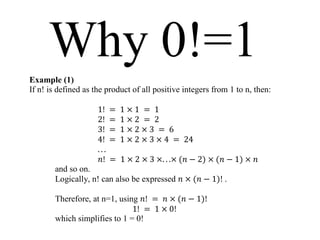Denunciar
Compartir

Recomendados
Más contenido relacionado
La actualidad más candente
La actualidad más candente (19)
Simultaneous equations - Vedic Maths Training Classes Pune - Bhushan 9370571465

Simultaneous equations - Vedic Maths Training Classes Pune - Bhushan 9370571465
Solving quadratic equation using completing the square

Solving quadratic equation using completing the square
2c. Pedagogy of Mathematics - Part II (Numbers and Sequence - Ex 2.3)

2c. Pedagogy of Mathematics - Part II (Numbers and Sequence - Ex 2.3)
2f. Pedagogy of Mathematics - Part II (Numbers and Sequence - Ex 2.6)

2f. Pedagogy of Mathematics - Part II (Numbers and Sequence - Ex 2.6)
2a. Pedagogy of Mathematics - Part II (Numbers and Sequence - Ex 2.1)

2a. Pedagogy of Mathematics - Part II (Numbers and Sequence - Ex 2.1)
Similar a 0!
Similar a 0! (20)
Solutions Manual for An Introduction To Abstract Algebra With Notes To The Fu...

Solutions Manual for An Introduction To Abstract Algebra With Notes To The Fu...
Más de Bed Dhakal
Más de Bed Dhakal (15)
0!
- 1. Why 0!=1 Example (1) If n! is defined as the product of all positive integers from 1 to n, then: 1! = 1×1 = 1 2! = 1×2 = 2 3! = 1×2×3 = 6 4! = 1 × 2 × 3 × 4 = 24 ... 𝑛! = 1 × 2 × 3 ×. . .× (𝑛 − 2) × (𝑛 − 1) × 𝑛 and so on. Logically, n! can also be expressed 𝑛 × (𝑛 − 1)! . Therefore, at n=1, using 𝑛! = 𝑛 × (𝑛 − 1)! 1! = 1 × 0! which simplifies to 1 = 0!
- 2. Example (2) Why 0!=1 The idea of the factorial (in simple terms) is used to compute the number of permutations of arranging a set of n numbers. n Number of Permutations (n!) Visual example 1 1 {1} 2 2 {1,2}, {2,1} 3 6 {1,2,3}, {1,3,2}, {2,1,3}, {2,3,1}, {3,1,2}, {3,2,1} Therefore, 0 1 {} It can be said that an empty set can only be ordered one way, so 0! = 1.
